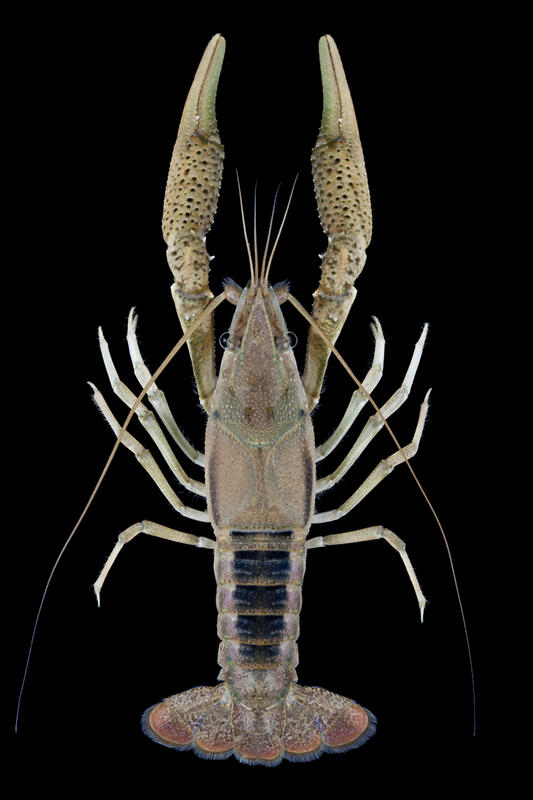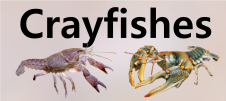







Loading profile. Please wait . . .
Procambarus lophotus Hobbs and Walton, 1960
Mane Crayfish




Federal Protection: No US federal protection
State Protection: No Georgia state protection
Global Rank: G5
State Rank: S4
Element Locations Tracked in Biotics: No
SWAP 2015 Species of Greatest Conservation Need (SGCN): No
SWAP 2025 Species of Greatest Conservation Need (SGCN): No
2025 SGCN Priority Tier: None
Element Occurrences (EOs) in Georgia: 0
Habitat Summary for element in Georgia: Associated with vegetation, rocks, or woody debris in streams; also in burrows near streams or in low wet areas
The overall color of the Mane Crayfish is light brownish to olive with a wide dark central stripe down the abdomen. The claws appear delicate and weak and the length of the mesial margin of the palm is usually about twice the width of the palm. The mesial margin of the palm is also about the same length of the movable finger. The areola is fairly narrow and strongly hourglass shaped, but never obliterated. The rostrum is relatively long, typically tapers, and occasionally has marginal spines or tubercles. A single small cervical spine or tubercle is usually present. This species reaches a maximum total body length of about 100 mm (3.9 in).
No other crayfish that occurs with Mane Crayfish has such long and delicate looking claws with such a long mesial margin of the palm. The White Tubercled Crayfish, Procambarus spiculifer is in the same genus but has two cervical spines instead of one found on Mane Crayfish.
The Mane Crayfish is considered a secondary burrower and thus is found in open water of flowing streams as well as burrow complexes along the banks of streams or in low wet areas near streams. Within a stream this species is found hiding beneath rocks, within woody debris and leaf litter, and beneath undercut banks.
No studies of the Mane Crayfish are known. Crayfishes are considered opportunistic omnivores and likely feed on live and decaying vegetation, aquatic insect larvae, small fishes, and dead animal matter.
Mane Crayfish is considered a secondary burrower which means that individuals live in open water part of the time but retreat to burrows as water levels decrease. As with stream dwelling species, reproduction likely occurs during the spring and fall, but males in reproductive condition may be found at any time during the year. When female crayfish are ready to lay eggs, they usually find a secure hiding place and hence are rarely encountered. In the case of secondary burrowers, females probably use burrows when they release their eggs. After the eggs are released, the female attaches them to her swimmerets and is said to be “in berry.” Upon hatching, the juvenile crayfish are attached to the mother by a thread. After the juveniles molt for the second time, they are free of the mother, but stay close and will hold on to her for some time. Eventually they move off on their own. Crayfishes molt 6 or 7 times during their first year of life and most are probably able to reproduce by the end of that year. They molt once or twice a year for the remainder of their lives and live about 3 years. In Georgia, male Mane Crayfish in reproductive condition have only been collected April and no females with eggs have been found. The smallest breeding male known is about 61 mm (2.4 in) in length (Hobbs 1981).
In clear streams, the species can be taken by carefully turning over rocks and pinning the animal by hand or gently steering it into a dipnet. It has also been found in muddy ditches where sweeping a dipnet or kicking beneath an undercut bank may yield specimens. Because this species frequently burrows, excavation of burrows adjacent to streams may reveal the species.
The Mane Crayfish is known from the Alabama River system in southwestern Alabama to northwestern Georgia and in the Tennessee River system in northwestern Georgia and southeastern Tennessee (Hobbs 1989). In Georgia it is common in the lower Conasauga and Chattooga rivers and the Chattanooga Creek system (Hobbs 1981).
This species is threatened in Georgia by land uses within its range that could alter hydrology and water quality. Introduction of non-native species is a threat to all native crayfishes.
This species is common and widespread in Georgia and is thus considered secure.
Conserving populations of the Mane Crayfish will require general watershed level protection measures, including the protection of riparian zones, control of sediment and nutrient runoff from farms and construction sites, and limiting the amount of impervious cover (e.g., pavement) within occupied watersheds. Non-native crayfishes should never be used for bait; instead, anglers should use crayfishes collected from the river system where they will be fishing. Unused bait of any kind should not be released back into Georgia waters.
Hobbs, H.H., Jr. 1981. The crayfishes of Georgia. Smithsonian Contributions to Zoology 318:1–549.
Hobbs, H.H., Jr. 1989. An illustrated checklist of the American crayfishes (Decapoda: Astacidae, Cambaridae, and Parastacidae). Smithsonian Contributions to Zoology 480:1–236.
Taylor, C.A., G.A. Schuster, J.E. Cooper, R.J. DiStefano, A.G. Eversole, P. Hamr, H.H. Hobbs III, H.W. Robison, C.E. Skelton, and R.F. Thoma. 2007. A reassessment of the conservation status of crayfishes of the United States and Canada after 10+ years of increased awareness. Fisheries 32:372–389.
Christopher E. Skelton
C. Skelton, 2012: original account
C. Skelton, March 2019: general update of account.
D.Weiler, October 2019: photo added